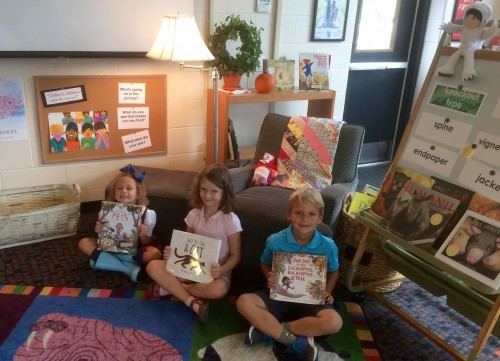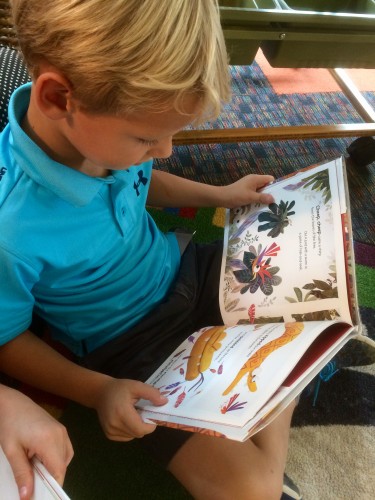2018 School Spending Survey Report
It’s become old hat for an artist to have more than one really great picture book out in the same year, but usually it’s a familiar name.
 It’s become old hat for an artist to have more than one really great picture book out in the same year, but usually it’s a familiar name. (Think Melissa Sweet, Jon Klassen, Philip Stead...) What’s unusual is when the artist has a rather unfamiliar name. This year, illustrator Brendan Wenzel has two books that many people mentioned when we made our call for titles: They All Saw a Cat and One Day in the Eucalyptus, Eucalyptus Tree. I did not have either of these titles, so I had to get myself up to speed. I called my friend, local school librarian Emmie Stuart from Percy Priest Elementary School. She's smitten with They All Saw a Cat. Indeed, she has already started her Caldecott project with her young students. We decided to write our review together because I love having a child’s-eye view of the books we are talking about here.
It’s become old hat for an artist to have more than one really great picture book out in the same year, but usually it’s a familiar name. (Think Melissa Sweet, Jon Klassen, Philip Stead...) What’s unusual is when the artist has a rather unfamiliar name. This year, illustrator Brendan Wenzel has two books that many people mentioned when we made our call for titles: They All Saw a Cat and One Day in the Eucalyptus, Eucalyptus Tree. I did not have either of these titles, so I had to get myself up to speed. I called my friend, local school librarian Emmie Stuart from Percy Priest Elementary School. She's smitten with They All Saw a Cat. Indeed, she has already started her Caldecott project with her young students. We decided to write our review together because I love having a child’s-eye view of the books we are talking about here.First, let me introduce you to Emmie. She has been working in her current job for four years. She is especially interested in the Whole Book Approach that Megan Lambert developed at the Eric Carle Museum of Picture Book Art and implements the approach in her teaching and sharing of children’s books. In a nutshell, the Whole Book Approach encourages children to respond to all of the visual and verbal information they gather as a picture book is read aloud. As a result, storytime becomes a conversational experience of reading with children rather than reading to children.
Since They All Saw a Cat brought up all sorts of questions in my brain, I figured it would be an especially interesting title to discuss with children. Emmie agreed.
Emmie: I introduced They All Saw a Cat with all my students, grades kindergarten to three. A brief discussion about the book’s jacket led each class to predict that the story was going to be about a cat. Next we examined the front and back endpapers, which caused a bit of intrigue — the colors are the same on the front and back endpapers, but the “texture” (the word choice of a third grader) is different. The front endpapers are short brown-and-pink strokes, while the back endpapers are long, nearly straight strokes in brown and pink with some other color.
Robin: How did they react to that?
Emmie: I remember one little girl in first grade declared that the opening endpapers were the cat’s hair when it was a baby (she didn’t use the word kitten or fur, and a few of her classmates were quick to correct her) and the back endpapers were the cat’s hair when it was old. As we began reading the story, most students were confused about what was happening.
Robin: How did the kids catch on?
Emmie: They were confused until the fish page, the page that shows the fish in focus and the cat is huge (all eyes and whiskers) and blurry. That page led to a lot of discussion where the kids began to figure out how the artist changed the art style to show how different creatures perceived the cat. After I read through the book, they wanted to go back and reexamine the entire book page by page to figure out why Wenzel chose each style.
Robin: I am curious about this myself!
Emmie: They wanted to talk about the worm underground. One student remembered that worms could not see or hear and that worms sense through feeling. Perhaps the lines represent vibration? The snake and bat pages also created quite a bit of speculation and student questioning. I found myself wondering right along with the kids and encouraging them to go on a research quest to find answers for their questions.
Robin: What else did they enjoy or notice about the book?
Emmie: Each page gave the kids an opportunity to talk about the art — perspective, color, size, the medium itself. Wenzel uses fingerpainting, cut-outs, brushes, pastels and several other techniques. The book’s jacket and casing are different, which always seems like a gift to the kids.
Robin: Does this book need end notes?
Emmie: Yes. I would assume the illustrator did research about the animals, but I would have loved a page at the end that explained his research or gave some ideas for the reader where to go for more scientific information. The kids kept asking questions along the lines of “Do skunks really only see in black and white?” and “Is this a true book?” I imagine the Caldecott committee will need to do that research themselves.
Robin: Oh, yes they will! I also suspect that this year’s committee will discuss both of Wenzel's books together. How do you think they compare to one another?
Emmie: Overall, I think They All Saw a Cat is more distinctive and memorable. There is just so much to talk about. One Day in the Eucalyptus, Eucalyptus Tree is colorful and full of energy, but the rollicking, rhyming words are what I took away from it.
Robin: I instantly thought that One Day in the Eucalyptus, Eucalyptus Tree would be a great book for acting out with puppets or as a play. The repeated rhyme is so funny and his illustrations (especially inside the snake’s “belly dark and deep”) really sticks with kids. However, the whole concept of They All Saw a Cat has stayed with me for a long time. I just hope both books are considered by the committee!


RELATED
RECOMMENDED
ALREADY A SUBSCRIBER? LOG IN
We are currently offering this content for free. Sign up now to activate your personal profile, where you can save articles for future viewing.








Add Comment :-
Comment Policy:
Comment should not be empty !!!
Megan Dowd Lambert
Hi Robin and Emmie! I just saw this post for the first time, and I am thrilled that the Whole Book Approach is mentioned as a strategy for engaging with this picture book in particular--it's one of my favorites of 2016. Put simply, it's storytime magic, and Emmie's experience reading it aloud with her students is similar to my own experiences. I would love to have informational back matter, too, but I also think a picture book can be a starting point for inquiry, a jumping off point to go see what else there is to see, so I don't think the absence of back matter is a fatal flaw.Posted : Dec 05, 2016 06:00
Robin Smith
Allison, thanks for your students' perspective on this book about perspectives. :) And Susan, I laughed out loud about the number of cats in Caldecott books. This book has humor and kid-appeal, neither of which is in the criteria, but I sure like books that make me laugh and appeal to kids. I especially like books that make kids slow down and think. I think this is one that will stay with the reader for a long time.Posted : Oct 31, 2016 12:57
Allison Grover Khoury
I really enjoyed this thoughtful review. Thanks very much. They All Saw A Cat was hugely popular in my 3 kinder classes as part of my Caldecott Reading Program. We had to talk through some of the perspectives. They were fascinated by the worm's perspective and the ending caused a lot of thoughtful conversation. I am looking forward to reading to 1st grade. I laughed out loud reading Eucalyptus Tree, and can't wait to read it to Kinder. The first class gets it next week.Posted : Oct 31, 2016 12:34
Susan M. Dailey
Robin & Emmie, thanks for the review of "They All Saw a Cat." I hadn't seen the book yet, but don't think I'd have figured out what was happening as quickly as Emmie's kids did. This is such an interesting concept. I particularly like the flea and bee's viewpoints. The addition of the red collar and the yellow bell help connect the illustrations--nice. I think it was Roger Sutton, Horn Book editor, who commented that librarians seem to love cats because they appear in many Caldecott winners. If that's true, this book should get a lot of love. :)Posted : Oct 28, 2016 11:26